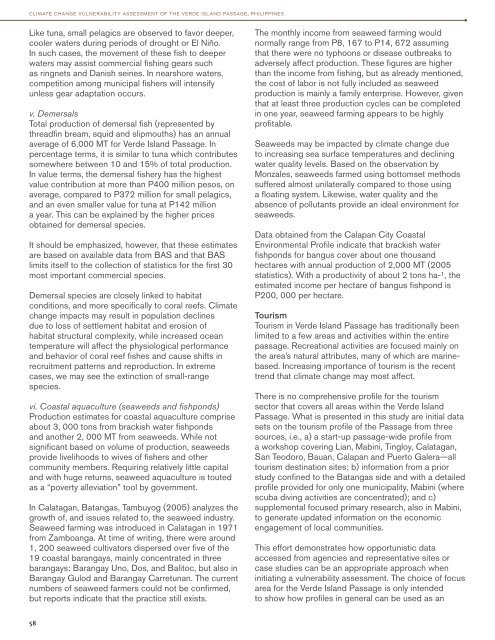of the Verde Island Passage, Philippines - weADAPT
of the Verde Island Passage, Philippines - weADAPT
of the Verde Island Passage, Philippines - weADAPT
Create successful ePaper yourself
Turn your PDF publications into a flip-book with our unique Google optimized e-Paper software.
climate change vulnerability assessment <strong>of</strong> <strong>the</strong> verde island passage, philippines<br />
Like tuna, small pelagics are observed to favor deeper,<br />
cooler waters during periods <strong>of</strong> drought or El Niño.<br />
In such cases, <strong>the</strong> movement <strong>of</strong> <strong>the</strong>se fish to deeper<br />
waters may assist commercial fishing gears such<br />
as ringnets and Danish seines. In nearshore waters,<br />
competition among municipal fishers will intensify<br />
unless gear adaptation occurs.<br />
v. Demersals<br />
Total production <strong>of</strong> demersal fish (represented by<br />
threadfin bream, squid and slipmouths) has an annual<br />
average <strong>of</strong> 6,000 MT for <strong>Verde</strong> <strong>Island</strong> <strong>Passage</strong>. In<br />
percentage terms, it is similar to tuna which contributes<br />
somewhere between 10 and 15% <strong>of</strong> total production.<br />
In value terms, <strong>the</strong> demersal fishery has <strong>the</strong> highest<br />
value contribution at more than P400 million pesos, on<br />
average, compared to P372 million for small pelagics,<br />
and an even smaller value for tuna at P142 million<br />
a year. This can be explained by <strong>the</strong> higher prices<br />
obtained for demersal species.<br />
It should be emphasized, however, that <strong>the</strong>se estimates<br />
are based on available data from BAS and that BAS<br />
limits itself to <strong>the</strong> collection <strong>of</strong> statistics for <strong>the</strong> first 30<br />
most important commercial species.<br />
Demersal species are closely linked to habitat<br />
conditions, and more specifically to coral reefs. Climate<br />
change impacts may result in population declines<br />
due to loss <strong>of</strong> settlement habitat and erosion <strong>of</strong><br />
habitat structural complexity, while increased ocean<br />
temperature will affect <strong>the</strong> physiological performance<br />
and behavior <strong>of</strong> coral reef fishes and cause shifts in<br />
recruitment patterns and reproduction. In extreme<br />
cases, we may see <strong>the</strong> extinction <strong>of</strong> small-range<br />
species.<br />
vi. Coastal aquaculture (seaweeds and fishponds)<br />
Production estimates for coastal aquaculture comprise<br />
about 3, 000 tons from brackish water fishponds<br />
and ano<strong>the</strong>r 2, 000 MT from seaweeds. While not<br />
significant based on volume <strong>of</strong> production, seaweeds<br />
provide livelihoods to wives <strong>of</strong> fishers and o<strong>the</strong>r<br />
community members. Requiring relatively little capital<br />
and with huge returns, seaweed aquaculture is touted<br />
as a “poverty alleviation” tool by government.<br />
In Calatagan, Batangas, Tambuyog (2005) analyzes <strong>the</strong><br />
growth <strong>of</strong>, and issues related to, <strong>the</strong> seaweed industry.<br />
Seaweed farming was introduced in Calatagan in 1971<br />
from Zamboanga. At time <strong>of</strong> writing, <strong>the</strong>re were around<br />
1, 200 seaweed cultivators dispersed over five <strong>of</strong> <strong>the</strong><br />
19 coastal barangays, mainly concentrated in three<br />
barangays: Barangay Uno, Dos, and Balitoc, but also in<br />
Barangay Gulod and Barangay Carretunan. The current<br />
numbers <strong>of</strong> seaweed farmers could not be confirmed,<br />
but reports indicate that <strong>the</strong> practice still exists.<br />
The monthly income from seaweed farming would<br />
normally range from P8, 167 to P14, 672 assuming<br />
that <strong>the</strong>re were no typhoons or disease outbreaks to<br />
adversely affect production. These figures are higher<br />
than <strong>the</strong> income from fishing, but as already mentioned,<br />
<strong>the</strong> cost <strong>of</strong> labor is not fully included as seaweed<br />
production is mainly a family enterprise. However, given<br />
that at least three production cycles can be completed<br />
in one year, seaweed farming appears to be highly<br />
pr<strong>of</strong>itable.<br />
Seaweeds may be impacted by climate change due<br />
to increasing sea surface temperatures and declining<br />
water quality levels. Based on <strong>the</strong> observation by<br />
Monzales, seaweeds farmed using bottomset methods<br />
suffered almost unilaterally compared to those using<br />
a floating system. Likewise, water quality and <strong>the</strong><br />
absence <strong>of</strong> pollutants provide an ideal environment for<br />
seaweeds.<br />
Data obtained from <strong>the</strong> Calapan City Coastal<br />
Environmental Pr<strong>of</strong>ile indicate that brackish water<br />
fishponds for bangus cover about one thousand<br />
hectares with annual production <strong>of</strong> 2,000 MT (2005<br />
statistics). With a productivity <strong>of</strong> about 2 tons ha-1, <strong>the</strong><br />
estimated income per hectare <strong>of</strong> bangus fishpond is<br />
P200, 000 per hectare.<br />
Tourism<br />
Tourism in <strong>Verde</strong> <strong>Island</strong> <strong>Passage</strong> has traditionally been<br />
limited to a few areas and activities within <strong>the</strong> entire<br />
passage. Recreational activities are focused mainly on<br />
<strong>the</strong> area’s natural attributes, many <strong>of</strong> which are marinebased.<br />
Increasing importance <strong>of</strong> tourism is <strong>the</strong> recent<br />
trend that climate change may most affect.<br />
There is no comprehensive pr<strong>of</strong>ile for <strong>the</strong> tourism<br />
sector that covers all areas within <strong>the</strong> <strong>Verde</strong> <strong>Island</strong><br />
<strong>Passage</strong>. What is presented in this study are initial data<br />
sets on <strong>the</strong> tourism pr<strong>of</strong>ile <strong>of</strong> <strong>the</strong> <strong>Passage</strong> from three<br />
sources, i.e., a) a start-up passage-wide pr<strong>of</strong>ile from<br />
a workshop covering Lian, Mabini, Tingloy, Calatagan,<br />
San Teodoro, Bauan, Calapan and Puerto Galera—all<br />
tourism destination sites; b) information from a prior<br />
study confined to <strong>the</strong> Batangas side and with a detailed<br />
pr<strong>of</strong>ile provided for only one municipality, Mabini (where<br />
scuba diving activities are concentrated); and c)<br />
supplemental focused primary research, also in Mabini,<br />
to generate updated information on <strong>the</strong> economic<br />
engagement <strong>of</strong> local communities.<br />
This effort demonstrates how opportunistic data<br />
accessed from agencies and representative sites or<br />
case studies can be an appropriate approach when<br />
initiating a vulnerability assessment. The choice <strong>of</strong> focus<br />
area for <strong>the</strong> <strong>Verde</strong> <strong>Island</strong> <strong>Passage</strong> is only intended<br />
to show how pr<strong>of</strong>iles in general can be used as an<br />
58
















